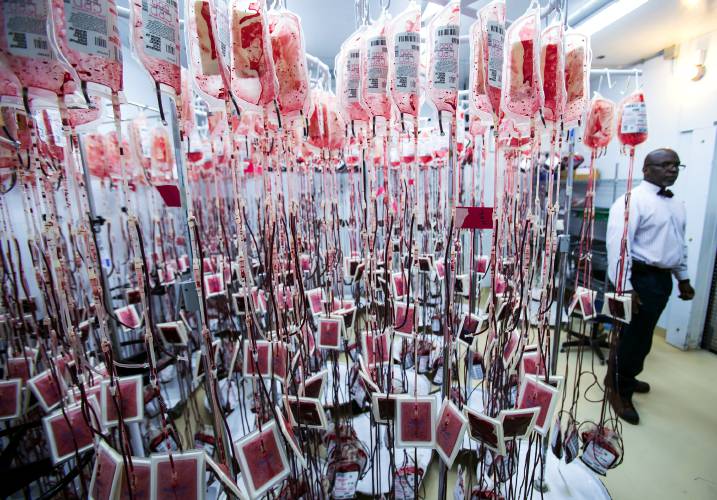The easiest way to help in a crisis – Give during National Blood Donor month. Here’s how

In this 2018 photo, American Red Cross Director of Manufacturing Edward Roberts Jr. stands in the refrigeration room at the organization’s Dedham, Mass., facility. Blood bags collected throughout the region are beginning the filtration process to be separated into component parts for transfusion. GEOFF FORESTER
|
Published: 01-22-2025 12:30 PM
Modified: 01-22-2025 10:37 PM |
Below-zero temperatures are a good excuse to find useful things to do indoors, so here’s an idea: Donate a pint of blood.
Each year, January is Blood Donation Month because mid-winter illness increases the need even as donations dip due to holidays and crummy weather. A current incentive from the Red Cross is that a donation means you’re entered in a drawing to win tickets to the Super Bowl. A secondary benefit are the free blood-pressure and hemoglobin tests, which cost a pretty penny at the doctor’s office.
The Red Cross collects blood all year round at scores of sites throughout the state, including its Concord office on Maitland Street and regularly scheduled collections at places like the National Guard Armory and the SEA/SEIU union offices on North Main Street. Donations can be scheduled at redcrossblood.org.
The process usually takes about an hour and doesn’t hurt much – just enough for you to feel virtuous – and usually includes free snacks, maybe even a slice of pizza. Walking around with your sleeve rolled up, showing off the bandage to colleagues and friends, is a bonus.
Each pint of blood collected here is taken to a processing facility in Dedham, Mass., where it is separated into component parts of the red blood cells that carry oxygen, the liquid portion known as plasma that performs a number of health functions, and blood-clotting platelets. These can be used by several different patients.
Nationally, blood donations declined sharply during COVID shutdowns and have taken a long time to return to pre-pandemic levels. They are needed all year because blood products cannot be stored indefinitely: Even with refrigeration and other technologies, red blood cells must be used within 42 days while platelets only last a week at most.
The Red Cross says 29,000 units of red blood cells are needed every day in the U. S. – a unit being the cells from one pint of donated blood – while 5,000 units of platelets and 6.500 units of plasma are necessary.
Donations are welcome from people with any of the four blood types but of particular need at the moment, according to the Red Cross, are people with O-negative and B-negative blood. People with Type O are valued as universal donors who can give blood to anybody, while those with a negative RH are especially valuable because they are uncommon. People with B-negative blood type are rarer: About 2% of white people have that blood type and the percentage is lower for other racial groups.
Article continues after...
Yesterday's Most Read Articles
If you’ve been rejected for lifestyle reasons in the past it’s worth the effort to try again: The FDA loosened its guidelines in late 2023.







 Outside, please: Concord outdoor dining begins for the season
Outside, please: Concord outdoor dining begins for the season ‘A full board’: After frustration, Chichester appoints a third selectman
‘A full board’: After frustration, Chichester appoints a third selectman Patriot Piecemakers craft quilts to honor veterans
Patriot Piecemakers craft quilts to honor veterans From raising chickens to programming a VR game, Merrimack Valley High School students show off their senior projects
From raising chickens to programming a VR game, Merrimack Valley High School students show off their senior projects
